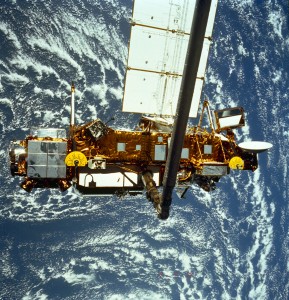
The Upper Atmosphere Research Satellite (UARS) during deployment from Space Shuttle Discovery in September 1991 (Credits: NASA Marshall Space Flight Center).
According to NASA experts, the UARS satellite is expected to reenter Earth’s atmosphere around September 23, earlier than previously anticipated. “Re-entry is expected Sept. 23, plus or minus a day,” said NASA, “The re-entry of UARS is advancing because of a sharp increase in solar activity since the beginning of this week.” The Upper Atmospheric Research Satellite (UARS) is a massive satellite launched in 1991 which ceased operations in 2005. The majority of the spacecraft is expected to burn up upon reentry, but there are about 26 large pieces which are likely to make it to the ground. According to NASA, no toxic fuel is left in the spacecraft’s tanks. Satellite fragments will be scattered over an are about 804 kilometers long. NASA expert said that the chance that a debris may hit a person is about 1 in 3200, since 75% of of Earth’s surface is covered in water and population is quite sparse in the remaining land. Victoria Samson, the Washington Office Director of the Secure World Foundation, an organization dedicated to the peaceful use of outer space, commented: “There’s a really good chance it’s going to go straight into the ocean.”


























































![A trajectory analysis that used a computational fluid dynamics approach to determine the likely position and velocity histories of the foam (Credits: NASA Ref [1] p61).](http://www.spacesafetymagazine.com/wp-content/uploads/2014/05/fluid-dynamics-trajectory-analysis-50x50.jpg)



Leave a Reply